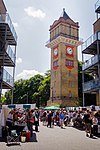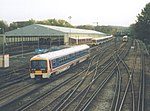Bombing of Sandhurst Road School
1943 disasters in the United Kingdom1943 in LondonCatfordDisasters in LondonHistory of the London Borough of Lewisham ... and 3 more
January 1943 eventsThe BlitzUse British English from November 2016
The bombing of Sandhurst Road School occurred during an air raid on Wednesday, 20 January 1943 when the school on Minard Road, Catford, south east London was seriously damaged. A German fighter-bomber dropped a single 500-kilogram (1,100 lb) bomb on the school at 12:30 pm, killing 38 children (32 killed at the school and 6 more died in hospital) and 6 staff and injuring another 60 people. Many were buried for hours under the rubble.
Excerpt from the Wikipedia article Bombing of Sandhurst Road School (License: CC BY-SA 3.0, Authors).Bombing of Sandhurst Road School
Sandhurst Road, London Catford South (London Borough of Lewisham)
Geographical coordinates (GPS) Address Nearby Places Show on map
Geographical coordinates (GPS)
| Latitude | Longitude |
|---|---|
| N 51.4428 ° | E -0.0004 ° |
Address
Sandhurst Infant and Junior School
Sandhurst Road
SE6 1UU London, Catford South (London Borough of Lewisham)
England, United Kingdom
Open on Google Maps







